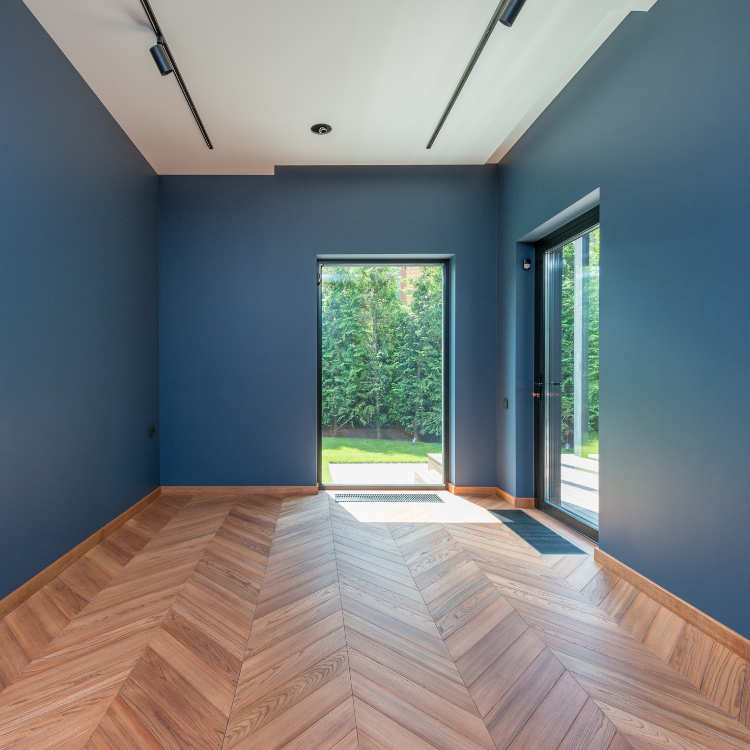Nothing is more frustrating for a homeowner than discovering paint peeling away from walls, ceilings, or exterior surfaces like old skin shedding from a sunburn. Whether you’re dealing with small flakes around window frames or large sections of paint curling away from entire walls, peeling paint represents more than just an aesthetic problem – it often signals underlying issues that require immediate attention to prevent costly damage to your home’s structure and value.
Understanding why paint peels in the first place is crucial for both addressing current problems and preventing future occurrences. Paint peeling rarely happens overnight or without cause. Instead, it typically results from a combination of factors that compromise the bond between paint and the surface beneath it. By recognizing these factors early and taking appropriate action, homeowners can maintain beautiful, durable paint finishes that protect their investment for years to come.
The most common misconception about peeling paint is that it’s simply a matter of poor-quality paint or improper application. While these factors certainly contribute to paint failure, the reality is far more complex. Environmental conditions, surface preparation, moisture issues, and even the age of your home all play significant roles in determining how long your paint will last and how well it will adhere to surfaces over time.
Understanding the Root Causes of Paint Peeling
Moisture stands as the primary culprit behind most paint peeling problems. When water infiltrates the layers beneath paint, it creates pressure that literally pushes the paint away from the surface. This moisture can come from various sources, including humidity, condensation, plumbing leaks, roof problems, or inadequate vapor barriers. In bathrooms and kitchens, constant exposure to steam and humidity creates ideal conditions for paint failure, especially when proper ventilation is lacking.
Poor surface preparation before painting represents another leading cause of peeling paint. When painters skip crucial preparation steps like cleaning, sanding, or priming, they create a weak foundation that cannot support the paint film long-term. Surfaces contaminated with dirt, grease, soap residue, or old paint that’s already failing will never provide adequate adhesion for new paint, regardless of the quality of materials used.
Temperature fluctuations cause paint and the underlying surface to expand and contract at different rates, creating stress that eventually leads to paint failure. This is particularly problematic on exterior surfaces that experience dramatic temperature swings between day and night or across seasons. Wood siding is especially susceptible to this type of paint failure because wood moves significantly with temperature and moisture changes.
Age and natural wear also contribute to paint peeling. Even the highest-quality paint job has a finite lifespan, typically ranging from five to ten years for exterior surfaces and longer for interior walls. As paint ages, it becomes more brittle and loses its flexibility, making it more susceptible to cracking and peeling when subjected to normal stress and movement.
Incompatible paint systems create another pathway to paint failure. Applying water-based paint over oil-based paint without proper preparation, or using interior paint in exterior applications, sets up conditions for premature peeling. Different paint types have different expansion rates and chemical compositions that may not bond well together without appropriate primer or surface preparation.
Identifying Different Types of Paint Peeling
Not all peeling paint looks the same, and understanding the different patterns can help identify the underlying cause and appropriate solution. Intercoat peeling occurs when the top layer of paint separates from the layer beneath it, often appearing as thin, papery flakes that expose the previous paint color. This type of peeling typically indicates inadequate surface preparation or incompatible paint types.
Adhesion failure manifests as paint peeling all the way down to the bare surface, often in large sheets or chunks. This dramatic failure usually indicates serious moisture problems or completely inadequate surface preparation. When you see paint curling away in large sections, especially on exterior surfaces, immediate investigation and remediation are necessary to prevent further damage.
Alligatoring describes a pattern where paint develops a scaly, reptilian appearance with interconnected cracks that eventually lead to peeling. This type of failure often results from applying paint over a surface that wasn’t properly cleaned or when a hard paint is applied over a softer, more flexible base coat.
Blistering appears as bubble-like formations in the paint film that eventually burst and peel away. This pattern almost always indicates moisture problems, either from external sources like rain infiltration or internal sources like humidity and condensation. The size and distribution of blisters can help pinpoint the moisture source.
Immediate Solutions for Addressing Peeling Paint
When dealing with peeling paint, the temptation is often to simply scrape away the loose material and apply new paint over the affected area. However, this approach typically leads to recurring problems because it fails to address the underlying cause. Successful paint peeling repair requires a systematic approach that begins with thorough investigation and preparation.
Start by carefully examining the affected area to determine the extent of the damage and potential causes. Look for signs of moisture intrusion, such as water stains, soft spots in wood, or mineral deposits on masonry surfaces. Check nearby plumbing, roof areas, and windows for potential water sources. Address any moisture issues before proceeding with paint repairs, as painting over wet or damaged surfaces will only lead to repeated failure.
Remove all loose and peeling paint completely, extending beyond the visibly damaged area to ensure you reach stable, well-adhered paint. Use appropriate tools for the surface and scale of the problem, ranging from putty knives and scrapers for small areas to sanders or paint strippers for extensive damage. Take precautions when removing old paint, especially in homes built before 1978, as lead paint requires special handling procedures.
Clean the exposed surface thoroughly to remove all dirt, grease, soap residue, mildew, and any remaining loose paint particles. Different surfaces require different cleaning approaches, but the goal is always to create a clean, sound foundation for new paint adhesion. Allow surfaces to dry completely before proceeding, as any remaining moisture will compromise the new paint job.
Apply appropriate primer to all exposed surfaces, choosing a product specifically designed for your surface type and the paint system you plan to use. Primer serves multiple critical functions: it seals porous surfaces, blocks stains, provides uniform adhesion, and ensures proper color development of the topcoat. Never skip primer, especially when dealing with previously failed paint areas.
Surface-Specific Repair Strategies
Wood surfaces require special attention when addressing peeling paint because wood movement contributes significantly to paint failure. Before repainting, inspect wood for rot, loose boards, or excessive moisture content. Replace any damaged wood and ensure proper caulking around joints and seams where water might penetrate. Sand all surfaces smooth and apply a high-quality primer designed for exterior wood before applying topcoats.
Masonry and stucco surfaces present unique challenges because these materials can be alkaline, which interferes with paint adhesion. Use an alkali-resistant primer specifically designed for masonry surfaces, and ensure the surface is completely dry before painting. Address any cracks or damage in the masonry itself before applying paint, as these imperfections will telegraph through the paint film and create failure points.
Metal surfaces require careful attention to rust prevention and proper primer selection. Remove all rust and corrosion completely before painting, as even small amounts of remaining rust will continue to spread beneath the paint film. Apply a rust-inhibiting primer designed for metal surfaces, and ensure proper ventilation during application and curing.
Drywall repairs often involve more than just scraping and repainting. Water damage that causes paint peeling on drywall may have also damaged the drywall itself. Check for soft spots, discoloration, or crumbling areas that indicate drywall replacement is necessary. Prime any repaired or new drywall areas with a high-quality drywall primer before applying finish coats.
Prevention Strategies for Long-Term Success
Preventing paint peeling requires addressing the underlying conditions that cause paint failure rather than simply applying better paint. Moisture control represents the most critical aspect of paint peeling prevention. Ensure proper ventilation in bathrooms, kitchens, and laundry areas. Install and use exhaust fans, maintain proper humidity levels throughout the home, and address any plumbing leaks promptly.
Regular maintenance plays a crucial role in preventing paint problems. Inspect your home’s exterior annually, looking for signs of moisture intrusion, loose caulking, damaged siding, or other issues that could lead to paint failure. Address small problems before they become major issues requiring extensive repairs.
Choose paint products appropriate for the specific conditions and surface type. Use high-quality exterior paints designed to withstand weather conditions in your area, and select interior paints with appropriate durability and moisture resistance for each room’s function. While premium paints cost more initially, they typically provide better long-term value through extended lifespan and reduced maintenance requirements.
Proper surface preparation before painting cannot be overstated in its importance for preventing future peeling. Clean all surfaces thoroughly, prime when appropriate, and allow adequate drying time between coats. Follow manufacturer recommendations for application conditions, including temperature and humidity requirements.
Professional Assessment and Intervention
While many homeowners can handle minor peeling paint repairs, extensive damage or recurring problems often require professional evaluation and remediation. Professional painters bring experience in identifying underlying causes and implementing comprehensive solutions that address both immediate problems and long-term prevention.
Signs that professional intervention may be necessary include extensive peeling over large areas, recurring peeling in the same locations despite repeated repairs, suspected moisture intrusion problems, or peeling paint in homes built before 1978 where lead paint may be present. Professional painters have access to specialized tools, materials, and expertise that can ensure proper diagnosis and repair of challenging paint peeling problems.
Professional painting contractors can also provide valuable guidance on paint selection, surface preparation techniques, and maintenance schedules that help prevent future problems. They understand local climate conditions and can recommend paint systems specifically suited to your area’s environmental challenges.
Making Informed Decisions About Paint Peeling
Dealing with peeling paint effectively requires understanding that it’s often a symptom of underlying problems rather than just a cosmetic issue. Quick fixes rarely provide lasting solutions, while comprehensive approaches that address root causes can provide decades of trouble-free performance. The key lies in accurate diagnosis, proper repair techniques, and ongoing maintenance to prevent future problems.
Don’t let peeling paint compromise your home’s beauty, protection, or value. Whether you’re dealing with minor touch-ups or extensive paint failure, the experienced professionals at Stone Painting have the expertise to diagnose the underlying causes and implement lasting solutions. Our team understands the unique challenges of Kansas City’s climate and can recommend the best approaches for your specific situation. From comprehensive surface preparation to high-quality material selection and expert application, we ensure your paint job will look beautiful and perform reliably for years to come. Contact us today for a free consultation and let us help you solve your paint peeling problems once and for all.

